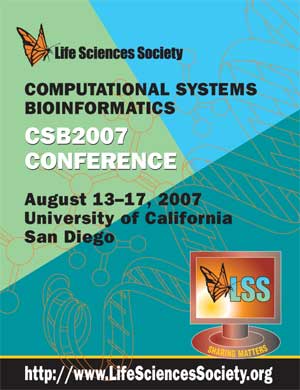Using Indirect Protein-Protein Interactions for Protein Complex Predication
Hon Nian Chua*, Kang Ning, Wing-Kin Sung, Hon Wai Leong, Limsoon Wong
Graduate School of Integrated Sciences, National University of Singapore, Singapore. g0306417@nus.edu.sg
Proc LSS Comput Syst Bioinform Conf. August, 2007. Vol. 6, p. 97-109. Full-Text PDF
*To whom correspondence should be addressed.

Protein complexes are fundamental for understanding principles of cellular organizations. Accurate and fast protein complex prediction from the PPI networks of increasing sizes can serve as a guide for biological experiments to discover novel protein complexes. However, protein complex prediction from PPI networks is a hard problem, especially in situations where the PPI network is noisy. We know from previous work that proteins that do not interact, but share interaction partners (level-2 neighbors) often share biological functions. The strength of functional association can be estimated using a topological weight, FS-Weight. Here we study the use of indirect interactions between level-2 neighbors (level-2 interactions) for protein complex prediction. All direct and indirect interactions are first weighted using topological weight (FS-Weight). Interactions with low weight are removed from the network, while level-2 interactions with high weight are introduced into the interaction network. Existing clustering algorithms can then be applied on this modified network. We also propose a novel algorithm that searches for cliques in the modified network, and merge cliques to form clusters using a "partial clique merging" method. In this paper, we show that 1) the use of indirect interactions and topological weight to augment protein-protein interactions can be used to improve the precision of clusters predicted by various existing clustering algorithms; 2) our complex finding algorithm performs very well on interaction networks modified in this way. Since no any other information except the original PPI network is used, our approach would be very useful for protein complex prediction, especially for prediction of novel protein complexes.
[CSB2007 Conference Home Page]....[CSB2007 Online Proceedings]....[Life Sciences Society Home Page]